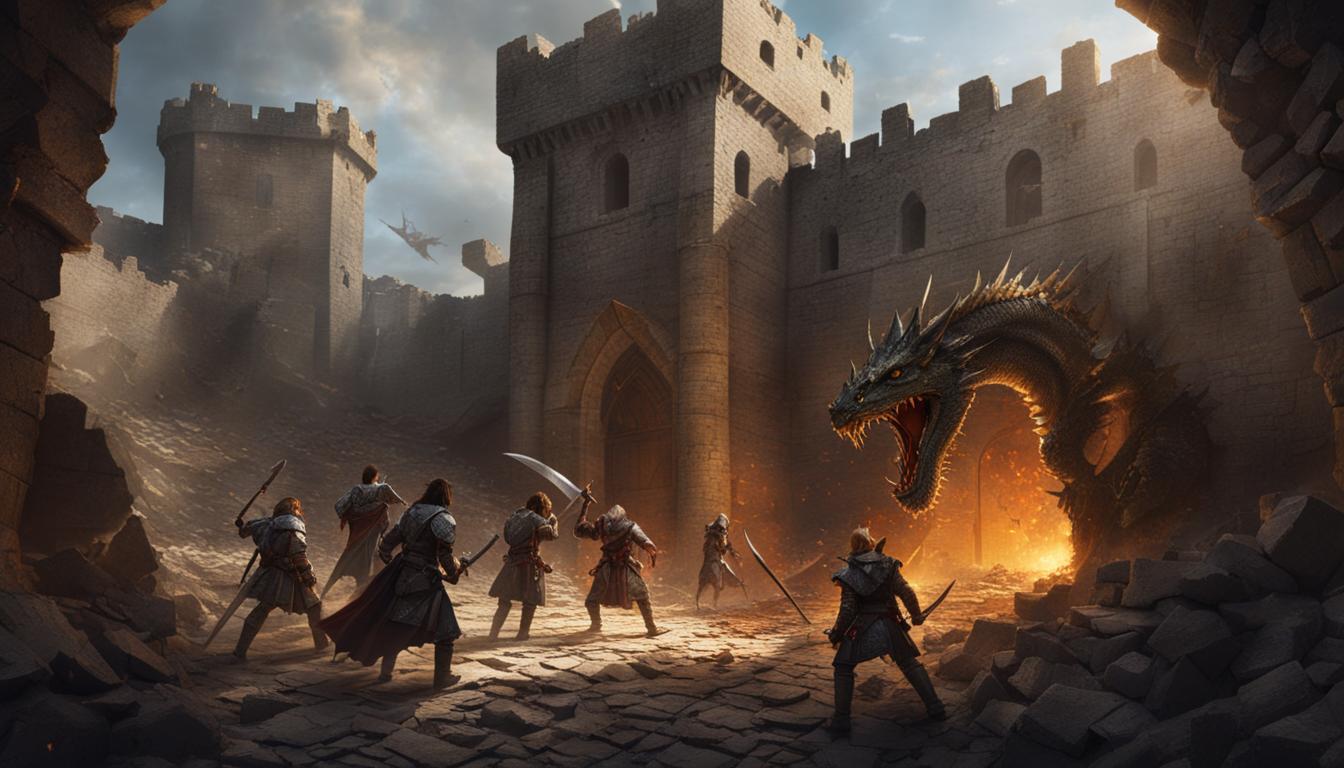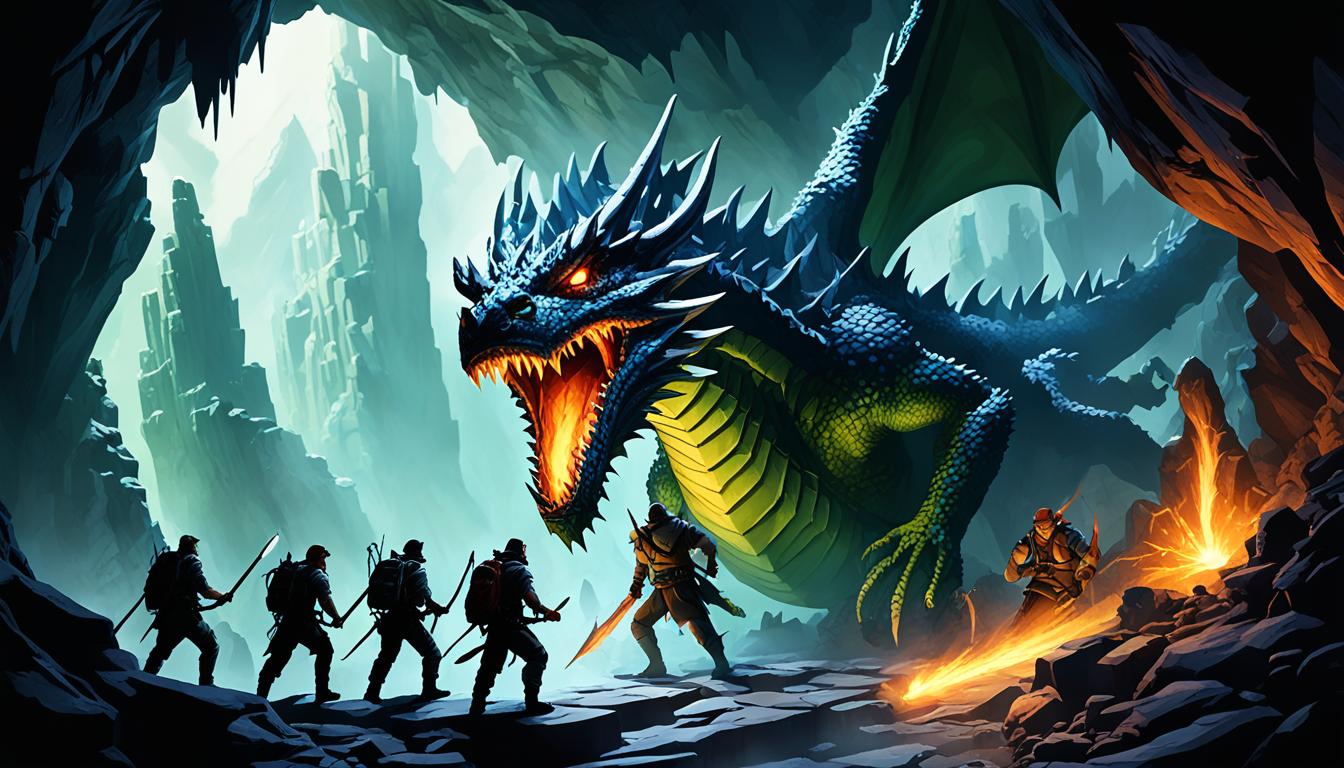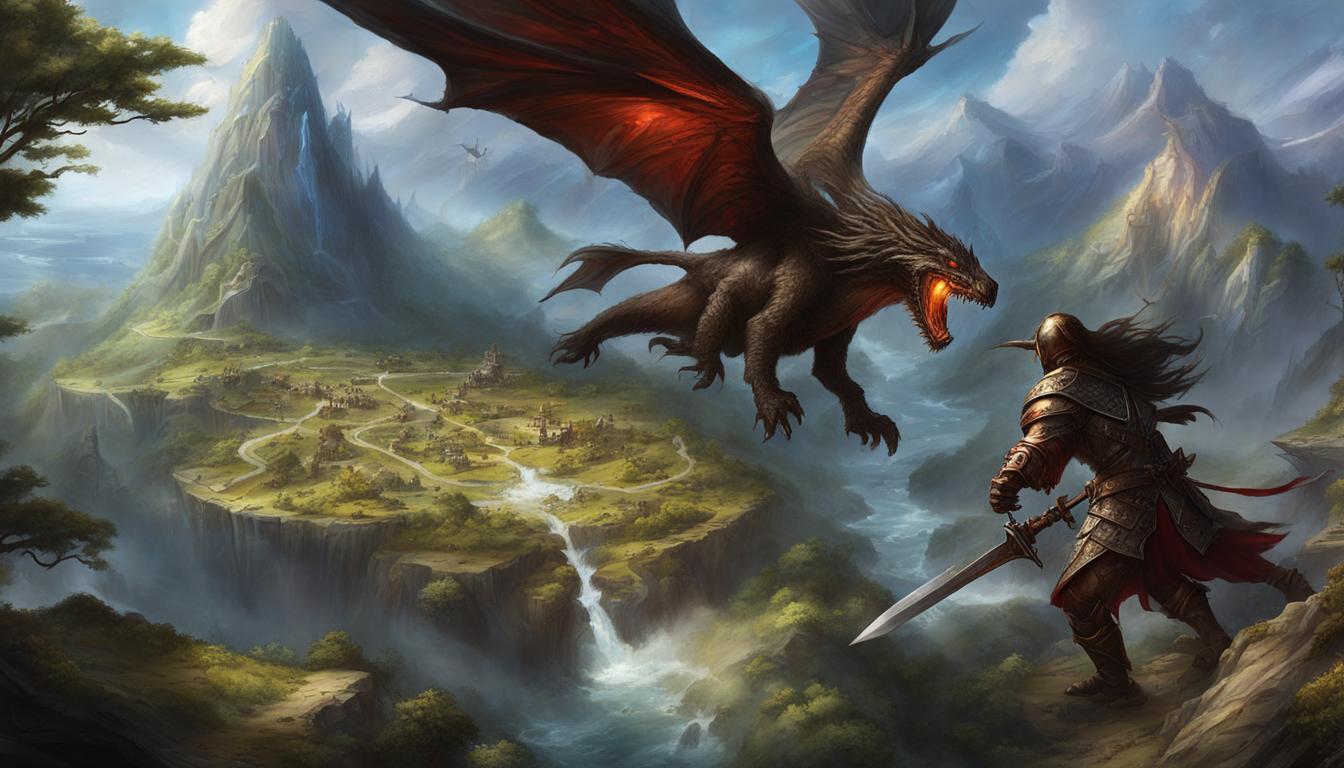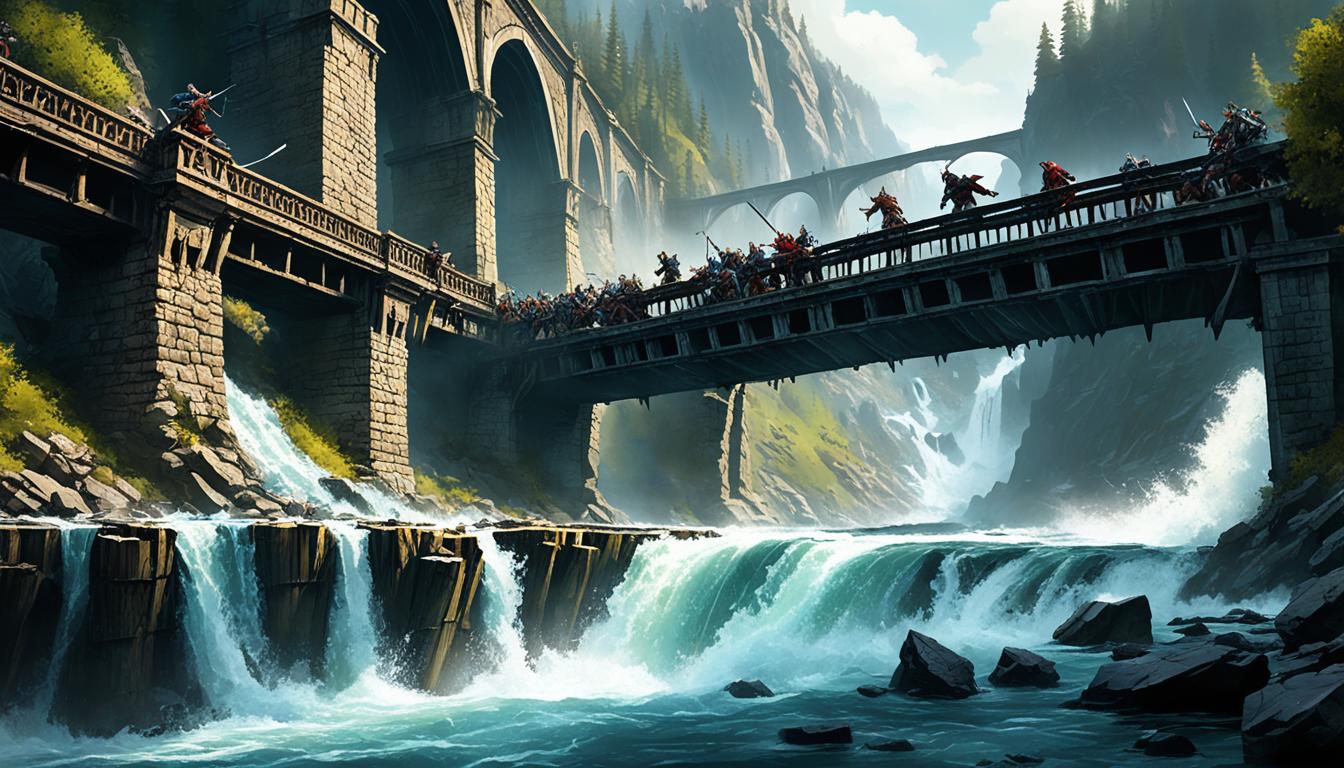Liven Up Your D&D Battles with Dynamic Environments
Once upon a time, in the fantastical world of Dungeons and Dragons, I found myself in an epic battle. My party and I faced off against a horde of bloodthirsty trolls in the heart of a dense forest. As the Dungeon Master described the scene, I could almost smell the damp earth and hear the rustling leaves.
The combat began, and we quickly realized that this was no ordinary skirmish. The forest itself seemed to come alive, with branches lashing out at us and vines snaking their way around our ankles. The trolls roared and charged, but we were not to be deterred.
We fought with everything we had, using our wits and our weapons to overcome the challenges the dynamic environment presented. We climbed towering trees to gain a tactical advantage, swung from vines to evade the trolls’ grasp, and even unleashed a lightning bolt that set the forest ablaze.
In that moment, I realized the true power of dynamic environments in D&D combat. The immersive experience of battling in a living, breathing world brought our game to life in a way we had never experienced before. It elevated our tactics, engaged our senses, and transformed a simple battle into an unforgettable adventure.

Join me on a journey to discover the wonders of dynamic environments in D&D combat. In this article, we will explore how interactive combat elements, evolving battlefields, and dynamic combat mechanics can breathe new life into your D&D game. Get ready to level up your combat encounters and create memorable experiences for you and your fellow adventurers.
Key Takeaways:
- Dynamic environments in D&D combat can enhance the immersion and excitement of battles.
- Interactive combat elements challenge players to think strategically and creatively.
- Evolving battlefields add depth and unpredictability to combat encounters.
- Dynamic combat mechanics keep players engaged and create suspenseful moments.
- Crafting a dynamic environment involves implementing hazards, terrain features, and other interactive elements.
Why Dynamic Environments are Crucial for Immersive D&D Combat
Dynamic environments play a crucial role in creating immersive and engaging combat experiences in Dungeons and Dragons (D&D). When it comes to D&D battles, the setting can greatly influence player engagement and investment in the game. By transitioning from static environments to dynamic ones, DMs can transform the battlefield and elevate the excitement, challenge, and strategic depth of combat encounters.
The Role of Setting in Player Engagement
In D&D, the setting of a battle is more than just a backdrop. It sets the stage for the players’ experiences and can greatly impact their level of immersion and investment in the game. By creating dynamic environments, DMs can transport players to vivid and captivating settings that enhance the overall atmosphere of the game.
Whether it’s a treacherous jungle filled with hidden traps or a crumbling castle amidst a raging storm, the setting can evoke a sense of urgency, danger, and excitement. It engages the players’ senses and prompts them to think strategically as they navigate through the dynamic elements of the battlefield.
Immersing players in a rich and detailed setting not only captivates their attention but also deepens their emotional connection to the game. When players feel a sense of investment in the world around them, their actions and decisions in combat hold more weight, leading to a more immersive and satisfying experience.
From Static to Dynamic: Transforming the Battlefield
The transition from static environments to dynamic ones is where combat in D&D truly comes alive. By introducing interactive elements, hazards, and changing landscapes, the battlefield becomes a dynamic space that challenges players and enhances their overall engagement in combat.
Dynamic environments can take various forms, such as collapsing bridges, shifting terrain, or unexpected weather patterns. These elements create a sense of unpredictability and force players to adapt their strategies on the fly. It introduces an element of surprise, keeping players on their toes and adding excitement to the battle.
Furthermore, dynamic environments invite players to think creatively and strategically. They are encouraged to use their surroundings to gain an advantage, whether it’s leveraging cover from falling debris or utilizing hazardous terrain to trap enemies. This level of interaction and strategic thinking adds depth and complexity to combat encounters, making them more memorable and engaging for all players involved.
| Static Environment | Dynamic Environment |
|---|---|
| Fixed terrain with minimal interaction | Interactive elements and hazards |
| Linear combat encounters | Adaptable and evolving battlefields |
| Predictable player strategies | Encourages creativity and inventive tactics |
Elevating Tactics with Interactive Combat Elements in D&D
Introducing interactive combat elements in Dungeons and Dragons (D&D) can take your battles to a whole new level of excitement and strategy. By incorporating traps, terrain features, and environmental hazards, you can significantly enhance the tactical depth of combat encounters.
Interactive combat elements provide more than just additional obstacles to overcome; they encourage players to think strategically and creatively. Players must consider their surroundings and how to best utilize the interactive elements to gain an advantage over their opponents.
These interactive elements can also foster teamwork and resourcefulness during battles. Cooperation and coordination among party members become crucial as they navigate through hazardous terrain and devise strategies to overcome traps and obstacles.
Moreover, incorporating interactive combat elements adds a sense of improvisation to battles. Players must adapt to the changing circumstances and make split-second decisions based on the evolving battlefield. This dynamic aspect keeps the combat engaging, challenging, and unpredictable.
By elevating tactics with interactive combat elements, you create a more immersive and strategic combat experience in D&D. Players are not only engaged in the immediate challenges presented by their adversaries but also must contend with the ever-present dangers of the environment. This combination of tactical decision-making and environmental awareness adds depth and excitement to your D&D battles.

Create an image of a group of adventurers fighting in a dynamic environment filled with interactive combat elements. The scene should feature various obstacles and terrain features that the characters can use to gain tactical advantages, such as narrow bridges, hidden traps, and crumbling pillars. The characters should be engaged in intense combat, with spells and weapons flying through the air. The setting should be richly detailed, with textures and lighting that bring the scene to life.
In the next section, we will explore how to craft a dynamic environment in D&D combat by implementing hazards and terrain features that further enhance the immersive experience.
Crafting a D&D Dynamic Environment in Combat: Implementing Hazards and Terrain
In order to create a truly immersive and exciting D&D combat experience, it’s important to craft dynamic environments that present unique challenges for the players. By implementing hazards and terrain features, you can add an extra layer of strategy and excitement to your battles.
One way to introduce dynamic elements is by utilizing natural disasters during combat. Earthquakes, floods, or storms can dramatically change the battlefield, creating unpredictable scenarios that require quick thinking and adaptability. Players must consider the shifting landscape and adjust their tactics accordingly to overcome these challenges.
Another effective way to craft dynamic environments is by incorporating dynamic terrain changes. This can include collapsing structures, shifting landscapes, or even magical effects that alter the battlefield. These changes introduce a sense of urgency and require players to think on their feet. They must navigate the terrain strategically, taking advantage of cover and using the environment to their advantage while remaining aware of potential dangers.
To add visual appeal and reinforce the concept of dynamic environments in combat, consider incorporating visual cues in your game. Use terrain props, such as miniatures or detailed maps, to represent hazards and changing terrain. This visual representation can help players visualize the challenges they face and adds an extra layer of immersion to the game.
Incorporating hazards and dynamic terrain changes in your D&D combat encounters not only creates thrilling and memorable battles but also encourages players to think strategically and adapt to changing circumstances. It adds an element of unpredictability and keeps players engaged throughout the game.
In the next section, we will explore how dynamic combat mechanics can further enhance the excitement and engagement of D&D battles.
Dynamic Combat Mechanics: Keeping Players on Their Toes
Dynamic combat mechanics are essential for keeping players engaged and adding excitement to D&D battles. By introducing surprise elements, random events, and unexpected twists during combat, players are constantly challenged to adapt their strategies in real-time.
Unpredictable combat scenarios create suspense and ensure that battles remain thrilling and unpredictable. These surprise elements not only keep players on their toes but also encourage active participation and engagement from all players involved.
Imagine a D&D battle where just as the players think they have the upper hand, the terrain suddenly shifts, altering the tactical landscape and forcing them to quickly reassess their approach. Or picture a battle where unexpected reinforcements arrive, turning what seemed like an easy fight into a tense struggle for survival. These dynamic combat mechanics ensure that no battle is ever predictable or monotonous.
With dynamic combat mechanics, players are constantly challenged to think creatively and adapt their strategies to the ever-changing battlefield. This adds an extra layer of depth and excitement to each encounter, making the overall D&D experience more immersive and memorable.
So, whether it’s unexpected environmental elements, surprise monster abilities, or unforeseen events, dynamic combat mechanics in D&D keep players engaged, motivated, and eager to face the next thrilling challenge.

Examples of Memorable D&D Dynamic Environment in Combat Scenarios
Memorable dynamic combat scenarios provide inspiration for creating exciting encounters in D&D. Players crave thrilling and immersive experiences that keep them on the edge of their seats. Let’s explore two scenarios that bring high-speed action and hazardous environments to the table.
Assault on a Moving Train: A High-Speed Combat Encounter
Imagine a daring mission where the party must battle enemies on a train hurtling through treacherous terrain. As the train picks up speed, players find themselves jumping between carriages, using acrobatics to dodge obstacles, and engaging in intense combat with enemies onboard.
The dynamic environment of a moving train introduces unique challenges and opportunities for creativity. Players must make split-second decisions, coordinating their moves to stay balanced and avoid being thrown off the train. The excitement of the chase, the clickety-clack of the train tracks, and the rush of adrenaline make this combat encounter unforgettable.
The Floor is Lava: Escaping a Fiery Fate while Fighting Foes
In this hazardous scenario, players find themselves within a room engulfed in flames. Lava seeps through the cracks in the floor, threatening to consume everything in its path. As if that weren’t enough, enemies lurk amidst the chaos, attacking the players while they must also avoid being burned alive.
The floor is lava scenario creates a sense of urgency and danger. Players must carefully navigate the room, hopping from safe platform to safe platform, all while battling adversaries. The unpredictable nature of the environment adds an extra layer of challenge, forcing players to prioritize their actions and adapt their strategies on the fly.
Using Destructible Environments to Add Urgency to D&D Encounters
Destructible environments can add a thrilling sense of urgency and tension to your D&D encounters. By incorporating elements such as flammable cover, crumbling structures, or explosive objects, you can create battles that are dynamic and unpredictable. Players must carefully consider the consequences of their actions and adapt their strategies accordingly when faced with these destructible environments.
Imagine a battle taking place in a dilapidated fortress, with wooden supports ready to give way at any moment. The players must navigate the battlefield, utilizing the cover provided by the decaying walls. However, the structure is fragile, and attacks from either side risk causing a collapse. This puts pressure on the players to quickly dispatch their enemies while also avoiding actions that could lead to catastrophic consequences.
Environmental destruction in dungeons and dragons can significantly impact the flow of combat and add an additional layer of challenge. Players must not only defeat their foes but also contend with a constantly changing battlefield. The tension created by the possibility of the environment turning against them keeps players engaged and on their toes throughout the encounter.

Mastering D&D Combat Tactics with Evolving Battlefields
When it comes to Dungeons and Dragons, combat encounters are a crucial part of the game. Mastering combat tactics can make the difference between success and failure in battles. One way to elevate your combat strategies is by utilizing evolving battlefields. These dynamic environments create opportunities for strategic thinking and adaptability.
Leveraging Collapsing Structures for Dramatic Effect
One powerful tactic to employ in D&D battles is utilizing collapsing structures. Whether it’s a crumbling tower or a collapsing bridge, the dramatic effect can be both visually striking and strategically advantageous. As the battlefield changes, players must adapt their strategies and plan their moves carefully to gain an advantage over their enemies.
Collapsing structures not only add a sense of urgency to battles but also create tense and impactful moments. The destruction and chaos can evoke a dramatic atmosphere, immersing players in the intensity of the combat.
Imagine a group of adventurers facing off against a horde of enemies on a collapsing bridge. As the bridge crumbles beneath their feet, they must strategically position themselves and time their attacks to navigate the treacherous terrain. The collapsing structure adds an element of risk and uncertainty, heightening the tension of the battle.
To enhance the dramatic effect of collapsing structures, Dungeon Masters can describe the crumbling of the infrastructure, the thunderous crashes, and the dust that fills the air. This vivid imagery immerses players in the intensity of the moment, making the combat experience truly memorable.
Players who can effectively leverage collapsing structures in combat demonstrate their mastery of not only combat tactics but also their ability to adapt to a changing environment. It requires careful planning, quick thinking, and resourcefulness.
So, next time you’re planning a D&D session, consider incorporating collapsing structures into your battles. Create a dynamic battlefield that challenges your players and allows them to showcase their combat prowess. The dramatic effect of collapsing structures will captivate your players, making for an unforgettable gaming experience.

Blending Exploration and Combat: Dynamic Battle Environments in D&D
Blending exploration and combat is a key aspect of creating dynamic battle environments in Dungeons and Dragons. By intertwining these two elements, DMs can provide players with thrilling and immersive gameplay experiences that reward their curiosity and strategic thinking.
The Secret Balcony: A Reward for Curiosity
During exploration, the discovery of a secret balcony can bring both excitement and a strategic advantage in combat. This hidden vantage point allows players to gain a tactical edge by obtaining a higher ground position or by ambushing enemies from an unexpected angle. It encourages players to actively explore their surroundings, uncover hidden secrets, and reap the rewards of their curiosity.
Plant Life with a Bite: When the Flora Fights Back
Adding interactive plant creatures to combat encounters introduces a unique and challenging element to battles. These plant-based adversaries not only engage in combat but also have special abilities or defenses linked to their natural environment. Players must navigate the battlefield carefully, taking into consideration the interactive nature of these creatures. They might need to avoid deadly thorns, manipulate the environment to their advantage, or find creative ways to neutralize these foes.
| Interactive Plant Creatures | Description |
|---|---|
| Venomous Vine | A plant creature that entangles and poisons its enemies with its winding tendrils. |
| Thornroot Defender | A massive tree-like creature with durable bark and deadly thorns, protecting its territory with lethal force. |
| Blossom Bomber | A small, seemingly harmless flower that explosively releases toxic pollen when disturbed. |
Blurring the lines between exploration and combat, these interactive plant creatures provide a dynamic and challenging element that keeps players engaged and on their toes.
Incorporate Dynamic Battles into Your D&D Campaign Today
Are you ready to take your D&D battles to the next level? By incorporating dynamic combat elements and enhancing your campaigns with dynamic environments, you can add excitement, challenge, and immersion to your game. Here’s how you can get started:
- Implement Interactive Elements: Introduce traps, terrain features, and environmental hazards that players can interact with during combat. These elements not only add tactical depth but also encourage strategic thinking and teamwork.
- Create Evolving Battlefields: Craft dynamic environments that change and evolve as the battle progresses. This could involve collapsing structures, shifting landscapes, or unpredictable weather conditions. Evolving battlefields keep players on their toes and require them to adapt their strategies accordingly.
- Experiment with Different Scenarios: Don’t be afraid to think outside the box and create unique combat scenarios. From high-speed combat encounters on a moving train to escaping from a room filled with fiery hazards, the possibilities are endless. Let your creativity run wild and surprise your players with memorable experiences.
Remember, the key to incorporating dynamic battles into your D&D campaign is to constantly engage your players and keep them excited about what’s happening on the battlefield. Don’t be afraid to challenge them, provide opportunities for creativity, and reward their strategic thinking. By creating dynamic environments, you can ensure that every battle is an immersive and thrilling experience.
So, what are you waiting for? Start incorporating dynamic battles into your D&D campaign today and watch as your players’ excitement and engagement soar.
Conclusion
Dynamic environments are an essential aspect of enhancing combat experiences and achieving immersion in the world of Dungeons & Dragons. By incorporating interactive elements, hazards, and evolving battlefields, players are not only engaged but also challenged to think strategically during combat encounters. The experimentation and creative implementation of dynamic environments can greatly elevate the overall enjoyment of your D&D game.
When players find themselves in a dynamic combat environment, they are compelled to adapt their tactics, make quick decisions, and rely on teamwork to succeed. The inclusion of hazards and interactive elements adds depth and excitement to battles, encouraging players to explore different strategies and work together to overcome challenges. The immersion achieved through dynamic environments brings the game to life, allowing players to truly become a part of the fantastical world they are adventuring in.
Whether it’s battling foes on a moving train, navigating a hazardous terrain, or confronting enemies in a destructible environment, the dynamic nature of these encounters creates suspense, tension, and a sense of urgency. As a Dungeon Master, it is crucial to design and implement dynamic environments that not only challenge your players but also provide them with opportunities for creative problem-solving and memorable experiences.